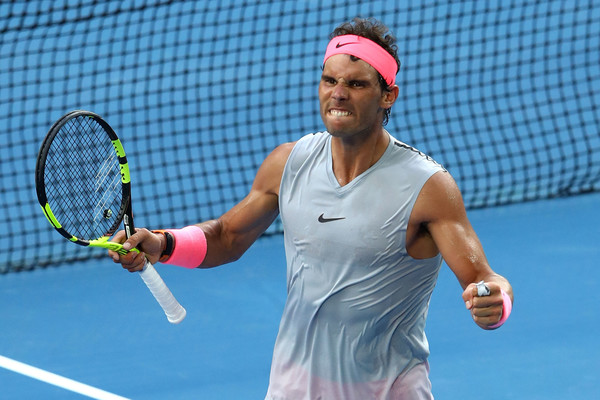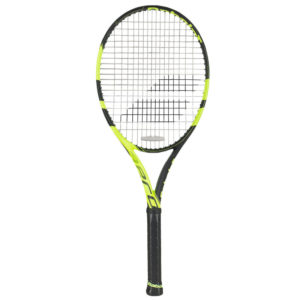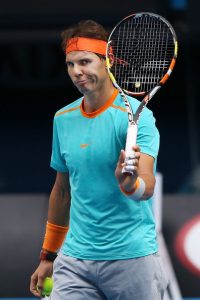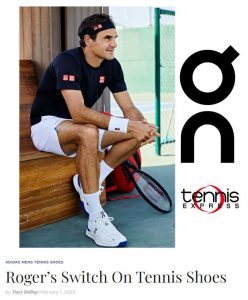 Not only has this line changed the face of tennis, but has given us a new meaning to the term “spin”. This has allowed players of all levels to hit the ball with more margin while still allowing an ample amount of power. With the addition of this new version, it’s almost been 20 years since the original Aero’s release. To pay tribute to this iconic racquet, let’s take a trip down memory lane and revisit the predecessors of the Aero dynasty.
Not only has this line changed the face of tennis, but has given us a new meaning to the term “spin”. This has allowed players of all levels to hit the ball with more margin while still allowing an ample amount of power. With the addition of this new version, it’s almost been 20 years since the original Aero’s release. To pay tribute to this iconic racquet, let’s take a trip down memory lane and revisit the predecessors of the Aero dynasty.
The Humble Beginnings
Starting way back in 2004, Babolat had been rather new to the racquet world and somewhat popular with the Pure Drive that was initially endorsed by Carlos Moya. After a young Spaniard named Rafael Nadal made his presence on the tennis tour, Babolat went to work to design a racquet, especially just for Rafa. The racquet would have to complement Rafa’s topspin-oriented game. Here’s where it gets interesting, a lot of you may think that the first Aero was the racquet Rafa used in 2004, but there was actually a model released a little earlier that looked like this. Pretty cool right!! Even though the racquet didn’t do too well, it was a step in the right direction. It led to the original Aero Pro Drive. This racquet was different from all the other racquets. It featured an Aero-modular beam that would allow the racquet to be more aerodynamic and also introduced the woofer technology in the grommets. It made the strings have a more trampoline effect when making contact with the ball which made the contact 25% longer. This resulted in a livelier ball making it very difficult to handle especially when heavy topspin is added. So, the combination of a more aerodynamic beam and livelier grommets made the first Aero Pro drive one of the most revolutionary game-changers in tennis. With this frame, Rafa was able to win his first 2 major titles.
Pretty cool right!! Even though the racquet didn’t do too well, it was a step in the right direction. It led to the original Aero Pro Drive. This racquet was different from all the other racquets. It featured an Aero-modular beam that would allow the racquet to be more aerodynamic and also introduced the woofer technology in the grommets. It made the strings have a more trampoline effect when making contact with the ball which made the contact 25% longer. This resulted in a livelier ball making it very difficult to handle especially when heavy topspin is added. So, the combination of a more aerodynamic beam and livelier grommets made the first Aero Pro drive one of the most revolutionary game-changers in tennis. With this frame, Rafa was able to win his first 2 major titles. 
Revolutionary Technology
The next version of the Aero Pro came in 2007 and added a new layer of technology that would permanently change the Aeros that came after. Keeping the same beam shape and woofer technology, Babolat once again rocked the tennis world with the addition of Cortex Technology. This was featured between the handle and frame of the racquet and also had a cool V-looking aesthetic. The purpose of Cortex was to dampen the harmful vibrations of the ball and filter it out leading to more comfort and a better feel. Since Babolat racquets have been on the stiffer side, this new addition made them even more playable for all types of players. This Aero Pro version featured a rather drastic cosmetic, change with a more prominent white and yellow scheme. Also, this frame is widely recognized because Rafa used it during the iconic 2008 Wimbledon final against Federer. With this version, Rafa was able to win his first two slams outside of Roland Garros; Wimbledon 2008 and the 2009 Australian Open.
The Era of Dominance
Coming to the next version of the Aero Pro, which was one of the most liked especially for the color scheme, this new Aero was released in 2010. With this frame, Rafa had arguably the best season of his career in 2010 winning three slams that year. With this new frame, a new technology by the name of GT came along. The purpose was to add higher-density fibers allowing for better strength and making the frame more stable on the head. Keeping all the other technologies present, with this version, for the first time in an Aero racquet partial gloss and matte finish was introduced which made the aesthetic look even better. Moving on to 2013 where once again, a new Aero was released. This version would be the last under the Aero Pro designation. The color scheme focused more on a darker and matte look. An update to cortex tech was added called ‘’active cortex’’. This was supposed to dampen the racquet even more while filtering out the unfriendly vibrations leading to a buttery feel on contact.
A New Identity
2016 was a revolutionary year for the Aero family. First and foremost, the racquet line’s name was changed from Aero Pro to Pure Aero. This change was made to make sure all the lines followed the same ‘’Pure’’ name. For the first time in this racquet’s history, there was a substantial structural change. The hoop was made a little thinner with the same Aero Modular tech leading to an even more aerodynamic frame. New grommets featuring FSI technology were added. This was added to some parts of the frame where the grommets were a little wider allowing the strings to move more creating more spin. Also, Cortex was moved inside the frame to make this racquet very sleek and minimal. Here’s a fun fact, even though this racquet was released in 2016, Rafa actually tested out a prototype of this version in early 2015. He tested it out briefly for a couple clay tournaments. The racquet was blacked out with some orange accents which were pretty cool.
This was added to some parts of the frame where the grommets were a little wider allowing the strings to move more creating more spin. Also, Cortex was moved inside the frame to make this racquet very sleek and minimal. Here’s a fun fact, even though this racquet was released in 2016, Rafa actually tested out a prototype of this version in early 2015. He tested it out briefly for a couple clay tournaments. The racquet was blacked out with some orange accents which were pretty cool.
Some Revolutionary Tech
After the successful launch of the Aero, Babolat decided to take tennis to the next level and introduced the Babolat Play rackets. The rackets came with sensors built into the racket that you could connect to your phone to analyze how many shots you hit, the placement on the string bed, average groundstroke speed, amount of spin, and much more. It was truly a new addition to the world of rackets. It spanned across two of their iconic models, the Pure Drive and the Aero line. The first Play racket was introduced back in 2013 and made its Aero debut in 2015 with one of the most unique cosmetics. The Play legacy carried on to the 2016 model but was eventually discontinued.

The Iconic "Banana Model"
In 2019, where the previous Pure Aero was released. This racquet followed the same design as its predecessor from 2016 but had some new tech. Aeromodular 3 was added to make this frame even more maneuverable, especially with the all-new Carbon Ply Stabilizer that was integrated to add more control and stability to shots. Also, SMAC tech was incorporated into this frame, which is a thin type of rubber that was placed at the 3 and 9 o’clock positions for improved feel and playability. The aesthetic of the frame put emphasis on the yellow color giving it its nickname of the ‘’banana aero’’. With this version, we could see some new colorways such as the Pure Aero Rafa that Nadal endorses. All in all, the Aero has seen it all. From an unpopular prototype to one of the most popular racquets in the tennis market. The unique look, incredible feel, attention to detail, and revolutionary technologies have given this racquet the popularity it has today. What makes the Aero line so great is that there is a frame for every type of player. There are lighter versions, heavier versions, and more classic-type frames such as the VS that focus more on control. This concludes our little trip down memory lane where we rediscovered the Aeros of the past. Join this great history and pick up the new Babolat Pure Aero at Tennis Express. Until Next Time!!!
All in all, the Aero has seen it all. From an unpopular prototype to one of the most popular racquets in the tennis market. The unique look, incredible feel, attention to detail, and revolutionary technologies have given this racquet the popularity it has today. What makes the Aero line so great is that there is a frame for every type of player. There are lighter versions, heavier versions, and more classic-type frames such as the VS that focus more on control. This concludes our little trip down memory lane where we rediscovered the Aeros of the past. Join this great history and pick up the new Babolat Pure Aero at Tennis Express. Until Next Time!!!
For More:





















